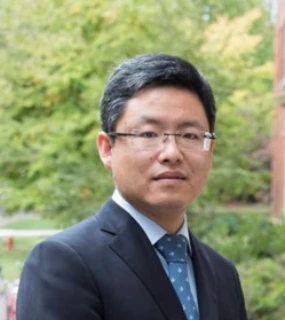3277 - Synthetic CT Generation for Ultrasound-Based Prostate HDR Brachytherapy Using a Cycle Diffusion Model
Presenter(s)

R. Liu1, Y. Lei2, Y. Lei1, M. Baine1, C. A. Enke1, and S. M. Zhou1; 1University of Nebraska Medical Center, Omaha, NE, 2Icahn School of Medicine at Mount Sinai, New York, NY
Purpose/Objective(s): This study presents a framework for generating synthetic CT images using a Cycle Diffusion model, which can be utilized to enhance needle conspicuity in ultrasound-guided prostate HDR brachytherapy.
Materials/Methods: The proposed Cycle Diffusion Network (CDN) framework synthesizes synthetic CT (sCT) images from ultrasound (US) data using advanced diffusion models, which have shown superior performance over traditional GANs in generating high-quality images. The process involves a forward diffusion phase, where Gaussian noise is incrementally added to the US image over multiple timesteps, perturbing the data toward a noise distribution. This is followed by a reverse diffusion phase, where a trained model iteratively denoises the data, guided by prior CT-ultrasound mappings to ensure accurate anatomical reconstruction. The framework evaluates the generated sCT image against quality criteria such as anatomical fidelity, intensity consistency, and structural accuracy. If the image does not meet the threshold, the process cycles back for further refinement, ensuring robust recovery of fine details. Validation was conducted using data from 10 prostate cancer patients treated with UHDR brachytherapy at the Fred & Pamela Buffett Cancer Center and a VIOMERSETM Prostate Phantom, with synthetic CTs compared against clinical and phantom CTs.
Results: The sCT images provide a clear visualization of the pubic bones, offering significantly improved clarity compared to the TRUS images. To quantitatively evaluate the generated sCT images against the ground truth CT, Mean Absolute Error (MAE) and Peak Signal-to-Noise Ratio (PSNR) were calculated. For phantom data, the MAE was 83.6 ± 15.3 HU, and the PSNR was 24.5 ± 4.1 dB. For patient data, the MAE was 58.4 ± 12.4 HU, and the PSNR was 25.6 ± 4.8 dB. Accurate visualization of bony structures, such as the pubic symphysis, is critical during UGHDR brachytherapy to ensure precise needle guidance and avoid complications. However, TRUS imaging has limited ability to clearly delineate bone edges due to poor acoustic reflection and signal artifacts. Generating sCT images from TRUS can overcome this limitation by providing enhanced visualization of bone edges while maintaining the real-time capabilities of ultrasound. The proposed Cycle Diffusion Network (CDN)-based framework aims to synthesize sCT images from TRUS data to enhance bone edge detection and visualization, enabling more accurate and efficient brachytherapy procedures.
Conclusion: This study presents a deep learning-driven approach for generating synthetic CT from ultrasound images during HDR brachytherapy, showing promising potential in enhancing needle conspicuity. Future efforts will focus on refining the proposed deep learning methodology by calibrating sCT with needle data.
